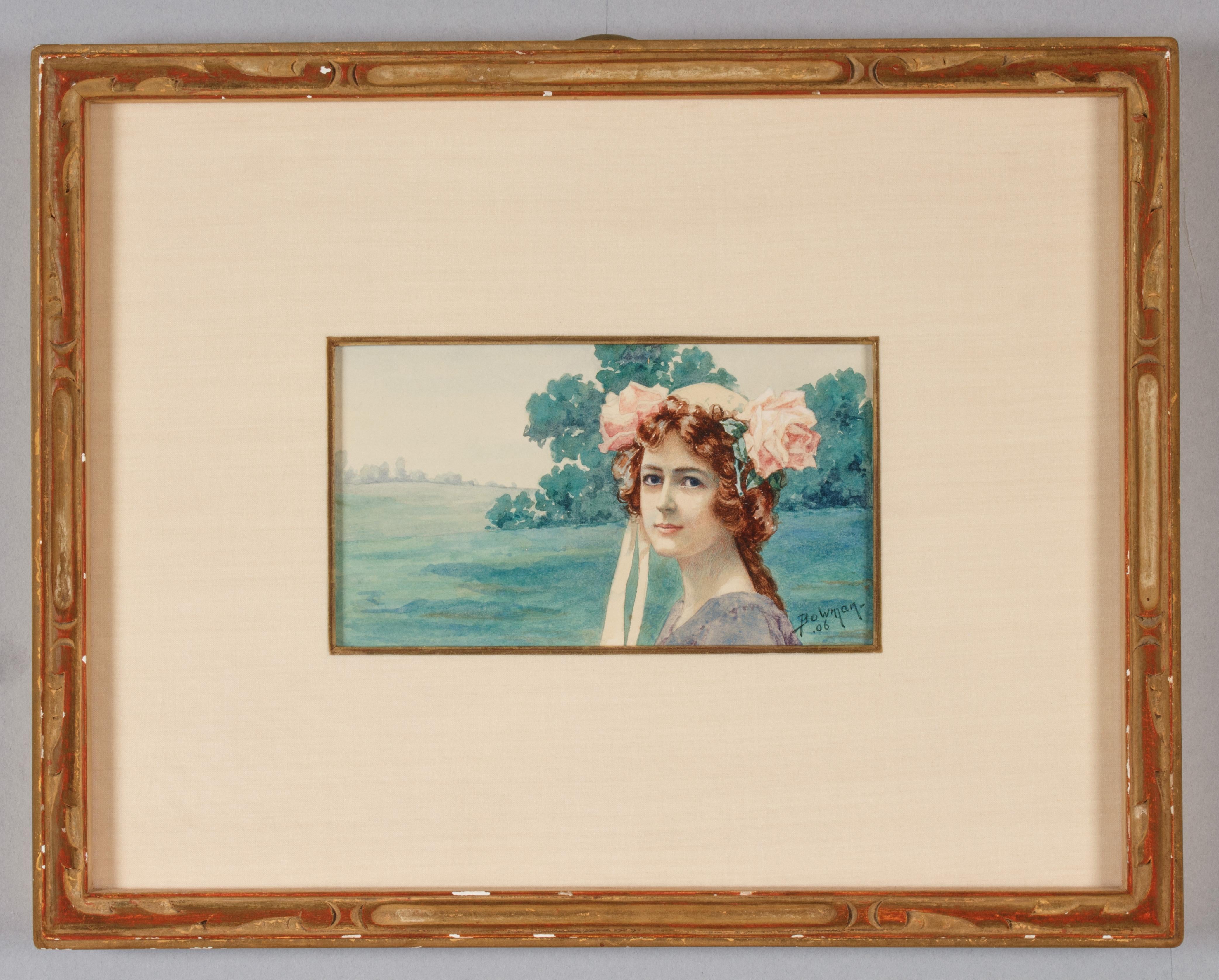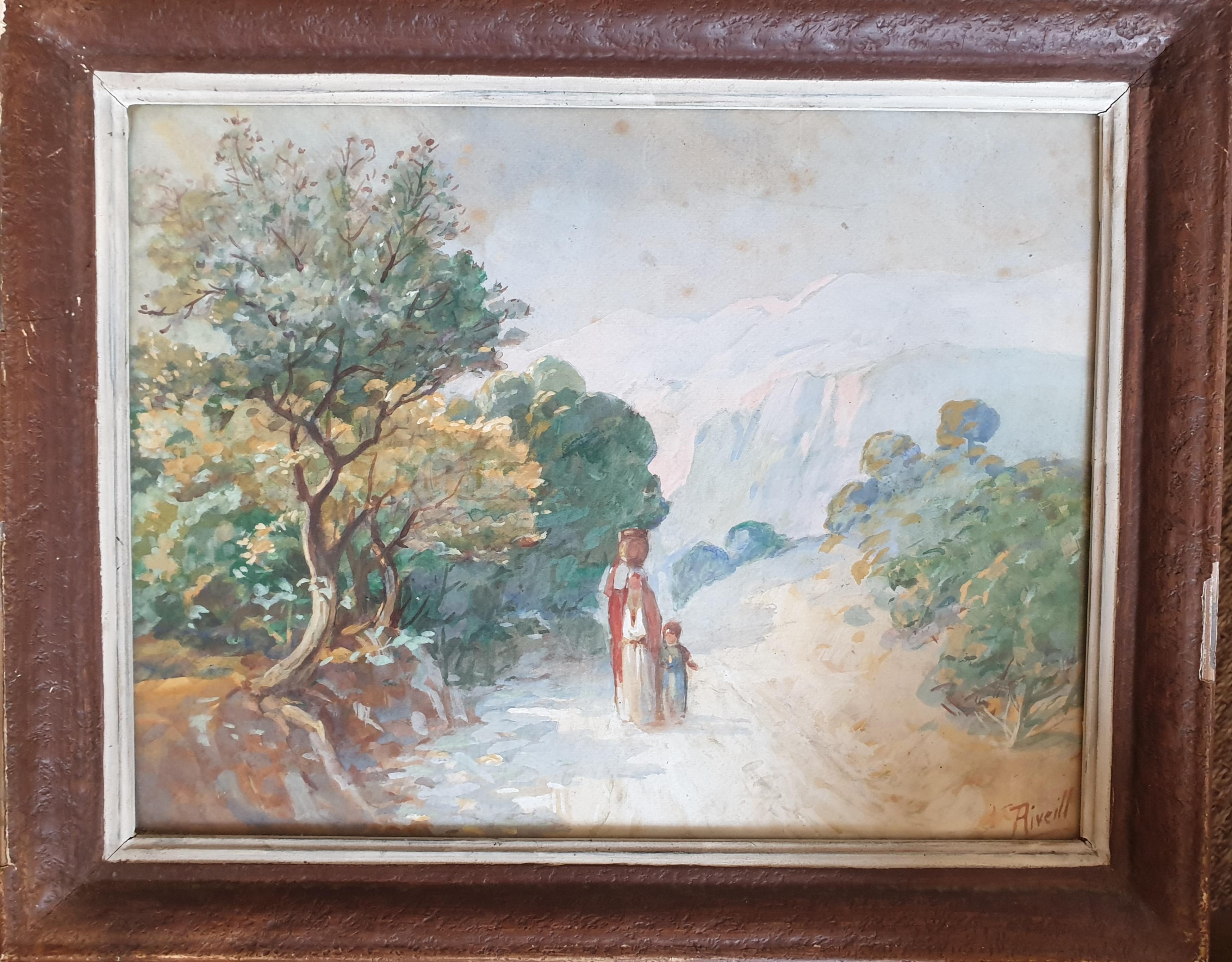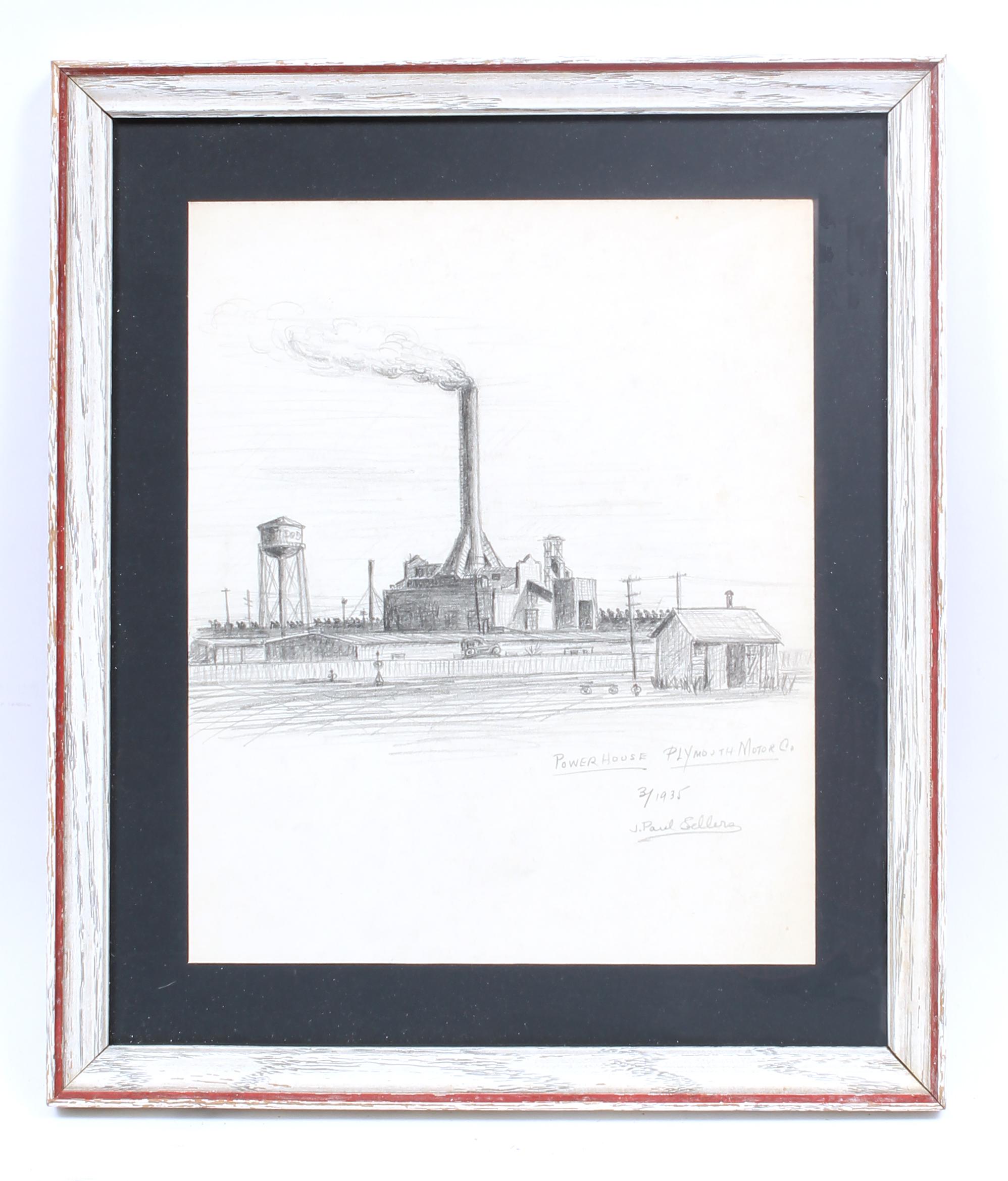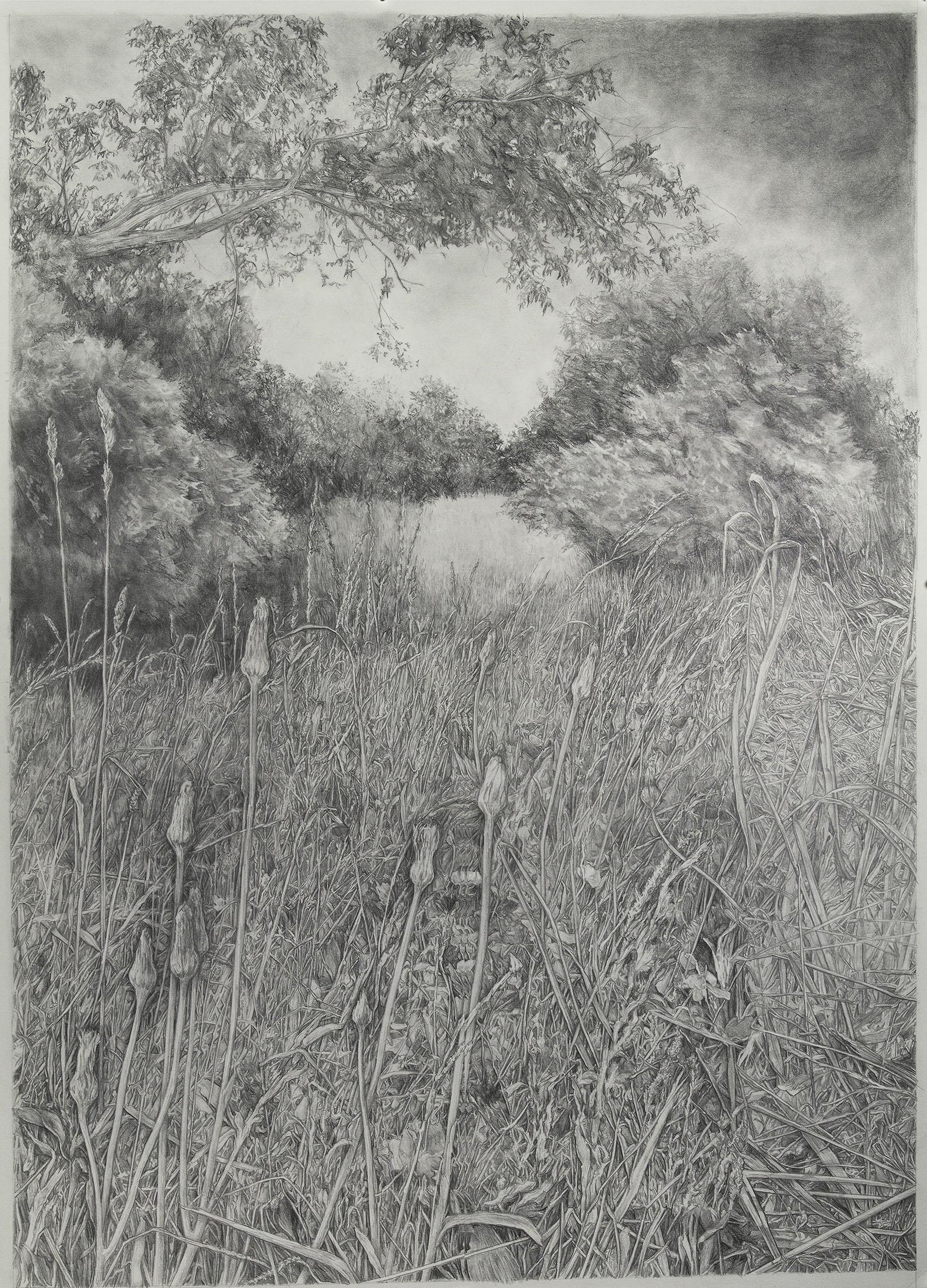Items Similar to Evening Cottage Scene / - Somewhere in Nowhere -
Video Loading
Want more images or videos?
Request additional images or videos from the seller
1 of 11
Arthur Claude StrachanEvening Cottage Scene / - Somewhere in Nowhere -
About the Item
Arthur Claude Strachan (1865 Edinburgh - 1954 Minehead), Evening Cottage Scene. Watercolor on paper, mounted, 28 x 46 cm (visible size), 48 x 65 cm (frame), signed "Claude Strachan." lower left. Framed in passepartout behind glass.
- The watercolor is in good condition, the frame a little rubbed at the corners and with a minor chip.
- Somewhere in Nowhere -
About the artwork
There is a path across the painting that we seem to have come to and will continue to follow. On this walk through the English countryside, we have come upon the cottage at the side of the path and have stepped aside to take a closer look. As invisible observers, we are presented with an evening scene that is all the more characteristic for its casualness, and that tells of the contemplative side of country life, which takes place timelessly away from the hustle and bustle of the city. The chimney of the cottage, which seems to have stood here forever, is smoking, and the door of the house is a little bit open. Apparently, the neatly dressed woman of the house has come out to fetch water to prepare the meal. She will go back inside, and also the ducks are probably on their way to their hutch.
In the direction in which the ducks are moving and in which the path leads, the sky on the horizon is inflamed by the evening red. Evening is approaching, and the whole picture is filled with an evening atmosphere that will pass into the blue hour. Even the water of the stream reflects the reddish sky.
It is in the depiction of the water that Strachan's mastery of watercolor is revealed. Not only is he able to depict both still and moving water, but he is also able to depict the reflections on the water and the water as a transparent medium through which we can view the riverbed.
This technical virtuosity, however, does not stand alone, it is an essential moment of the pervading atmosphere of the picture, to which the flower garden, merging into the 'wild' nature, also contributes. The gate to it is open or missing, which is like an invitation to have a closer look at the flowers and to enjoy the beauty of this cultivated creation. The evening atmosphere is also present here - the sunflowers have already tilted their heads.
The entrance to the cottage is also flanked by flowers, while plants grow from the roof. Together with the thatched roof and the half-timbered walls, the house itself looks like a part of nature, which is further enhanced by the fact that the windows to the left of the entrance reflect like the surface of the water.
The whole scenery could have been taken from William Morris's utopian novel News from Nowhere (1890) and shows that utopia is not utopia but reality.
About the artist
Arthur Claude Strachan studied at the Liverpool Academy of Art and then worked as a watercolorist, capturing rural life far from the hustle and bustle of the city. He traveled extensively throughout Great Britain and lived in Evesham, Wallasey and Minehead.
Strachan's work has been exhibited at the Walker Art Gallery in Liverpool and the Royal Academy in London.
GERMAN VERSION
Arthur Claude Strachan (1865 Edinburgh - 1954 Minehead), Abendliche Landhausszene. Aquarell auf Papier, kaschiert, 28 x 46 cm (Sichtmaß), 48 x 65 cm (Rahmen), unten links mit „Claude Strachan.“ signiert. Im Passepartout hinter Glas gerahmt.
- Das Aquarell ist in gutem Zustand, der Rahmen an den Ecken etwas berieben und mit kleinerer Fehlstelle.
- Irgendwo im Nirgendwo -
zum Kunstwerk
Es führt ein Weg quer durchs Bild, auf dem wir gekommen zu sein scheinen und dem wir weiter folgen werden. Auf diesem Gang durch die englische Landschaft sind wir auf das am Wegesrand liegende Landhaus gestoßen und etwas beiseitegetreten, um es ganz in Augenschein nehmen zu können. Als unsichtbare Betrachter bietet sich uns eine abendliche Szenerie dar, die in ihrer Beiläufigkeit umso charakteristischer ist und von der beschaulichen Seite des Lebens auf dem Lande berichtet, das sich wie zeitlos abseits der Großstadthektik vollzieht. Der Schornstein des scheinbar schon ewig hier stehenden Landhauses raucht und die Tür des Hauses ist einzig angelehnt. Offenbar ist die gepflegt gekleidete Frau des Hauses herausgekommen, um Wasser für die Zubereitung des Essens zu schöpfen. Sie wird wieder ins Haus gehen und auch die Enten sind wohl auf dem Weg zu ihrem Verschlag.
In der Richtung, in welche sich die Enten bewegen und in die der Weg führt, ist der Himmel am Horizont vom Abendrot entflammt. Es geht auf den Abend zu und das ganze Bild ist von einer Abendstimmung erfüllt, die in die blaue Stunde übergehen wird. Selbst auf dem Wasser des Bachlaufs sind Reflexe des rötlichen Himmels zu sehen.
Gerade in der Darstellung des Wassers zeigt sich Strachans meisterliche Aquarellmalerei. Ihm gelingt es nicht allein, gleichermaßen unbewegtes wie bewegtes Wasser zu veranschaulichen, er vermag auch die Reflexionen auf dem Wasser und das Wasser dabei zugleich als durchsichtiges Medium darzustellen, durch welches wir auf das Bachbett schauen können.
Diese technische Virtuosität steht aber nicht für sich, sie ist ein ganz wesentliches Moment der allesdurchwaltenden Bildatmosphäre, zu der auch der in die ‚wilde‘ Natur übergehende Blumengarten beiträgt Die Pforte zu ihm hin steht offen oder fehlt ganz, was einer Einladung gleichkommt, die Blumen näher zu betrachten und sich an der Schönheit dieser kultivierten Schöpfung zu erfreuen. Auch hier ist die Abendstimmung präsent - die Sonnenblumen haben bereits ihre Köpfe geneigt.
Der Eingang zum Landhaus wird ebenfalls von Blumen flankiert, während vom Dach kaskadenartig Schlingpflanzen herabwachsen. Zusammen mit dem Reetdach und dem Fachwerk wirkt das Haus selbst wie ein Teil der Natur, was zusätzlich verstärkt wird, indem die Fenster links vom Eingang wie die Oberfläche des Wassers reflektieren.
Die ganze Szenerie könnte William Morris utopischem Roman Kunde von Nirgendwo (1890) entnommen sein und führt vor Augen, dass die Utopie nicht Utopie, sondern Realität ist.
zum Künstler
Arthur Claude Strachan studierte an der Kunstakademie Liverpool und war anschließend als Aquarellmaler tätig, der in seinen Bildern das Landleben fernab der Großstadthektik festgehalten hat. Dazu bereiste er intensiv Großbritannien und lebte in Evesham, Wallasey und Minehead.
Werke Strachans wurden unter anderem in der Walker Art Gallery in Liverpool und der Royal Academy London gezeigt.
- Creator:Arthur Claude Strachan (1865 - 1954, Dutch)
- Dimensions:Height: 18.9 in (48 cm)Width: 25.6 in (65 cm)Depth: 1.97 in (5 cm)
- Medium:
- Movement & Style:
- Period:
- Condition:
- Gallery Location:Berlin, DE
- Reference Number:1stDibs: LU2438212736472

About the Seller
5.0
Vetted Seller
These experienced sellers undergo a comprehensive evaluation by our team of in-house experts.
Established in 2014
1stDibs seller since 2023
7 sales on 1stDibs
Typical response time: 7 hours
- ShippingRetrieving quote...Ships From: Berlin, Germany
- Return PolicyA return for this item may be initiated within 14 days of delivery.
More From This SellerView All
- The Ruins of St. Clement's Church in Visby, Sweden / - Real romanticism -Located in Berlin, DEOtto Günther-Naumburg (1856-1941), The Ruins of St. Clement's Church in Visby, Sweden. Watercolor and ink, heightened with white, on sand-colored paper, mounted on cardboard, 33 x 24...Category
Early 20th Century Realist Landscape Drawings and Watercolors
MaterialsPaper
- Shady hollow way - Into the heart of the forest -By Hans DvoràkLocated in Berlin, DEHans Dvořák (19th century). Shady hollow way in a sunny forest. Watercolour and pen-and-ink drawing, 58.5 x 43 cm (visible size), 70 x 55.5 cm (frame), signed and dated "Hans Dvořák ...Category
1880s Realist Landscape Drawings and Watercolors
MaterialsWatercolor
- High Moorland Landscape in the fog - The world as a transcendent phenomenon -Located in Berlin, DECharles Edward Brittan Jr (1870 Plymouth - 1949). High moor landscape in the fog. Gouache, signed at lower left "Charles E. Brittan", 18 x 34.5 cm (passepartout), 45 x 62 cm (frame)....Category
Early 20th Century Realist Landscape Drawings and Watercolors
MaterialsWatercolor
- Red blooming war landscape with dead soldier - Bleeding flowers -Located in Berlin, DEJohannes Friedrich Heinrich Hänsch (1875-1945), Red blooming war landscape with dead soldier, 1918. Watercolor and gouache on paper, 15 x 24.5 cm (image), 27 x 37 cm (sheet size / frame), monogrammed and dated "19JH18" at lower left. - Paper slightly darkened About the artwork Despite the relatively small format, the watercolor with an internal frame depicts a panoramic view of a flat landscape stretching to the horizon. As far as the eye can see, the poppies bloom in flaming red. The flowers are not rendered individually, however, creating an almost cohesive red surface. The bright red is interspersed with vegetal green. A complementary contrast that creates an intense color effect. In this color contrast, a white area breaks through from the middle ground, widening towards the foreground and surrounding a brown hole. Next to it, in blue, is the actual protagonist of the painting, the first thing that catches the eye: a dead soldier. Next to him is his helmet, revealing the empty interior. The brown, hollow shape corresponds to the hole in the ground. A shell funnel is surrounded by bright ash, which, like the inverted helmet, becomes a sign of death. The soldier's arms point to the funnel, while the empty helmet paraphrases the calotte of the skull and, like the funnel, thematizes the empty darkness of death. The soldier's body, however, is intact and not - as in Otto Dix's triptych "The War" - a dismembered corpse. Instead, Johannes Hänsch activates the landscape, especially the color, to illustrate a blooming landscape of death that extends from the shell funnel in the foreground to the rising column of smoke on the horizon. If the soldier's body is intact, the tangle of barbed wire emblematically placed over the empty helmet also appears tattered. On the right side of the picture, the barbed wire even seems to stretch its arms to the sky in horror. Against the background of this allegory, the content of the bright red also becomes clear: the landscape is drenched in blood, literally a sea of blood, and the single unknown soldier stands pars pro toto for all those who died on the battlefield. Dying in war is not dying in community, but in solitude. In order to emphasize the isolation in death, Johannes Hänsch has set the blue of the soldier in the axis given by his body in the middle ground of the picture into the red sea. A master of landscape painting, Hänsch succeeds in creating a natural-looking landscape allegory that illustrates the horror and death of war, without depicting the brutality of war itself. This singular 'war memorial' of the unknown soldier is the opposite of heroization and yet the dignity of the deceased soldier is preserved through the integrity of his body. About the artist As the son of the sculptor Adolf Haensch, the young Johannes received his first artistic training in his father's Berlin studio. However, he eventually decided to become a painter, and in 1897 he entered the Berlin Academy of Arts. He initially studied under Paul Vorgang and Eugen Bracht, and was particularly influenced by Bracht's increasingly colourful landscape painting. In 1901 he moved to the class of Friedrich Kallmorgen, with whom he spent several weeks on excursions into nature. In 1905 he became a master pupil of Albert Hertel, who taught him watercolour painting. From 1903 to 1933 he exhibited annually at the Great Berlin Art Exhibition, the exhibitions of the Berlin Artists' Association and the Munich Glaspalast. In 1905 he was awarded the Carl Blechen...Category
1910s Realist Figurative Drawings and Watercolors
MaterialsWatercolor
- Wettersteinkamm - The blue of the mountains -Located in Berlin, DEAdalbert Holzer (1881 Munich - 1966 Munich). Wettersteinkamm. Watercolour, 29 x 34.5 cm (visible size), 37.5 x 43 cm (frame), signed and dated at lower right 'ADALBERT HOLZER [19]23'. Framed behind glass. Frame shows signs of wear. - The blue of the mountains - About the artwork The Wetterstein ridge is revealed to the viewer from a gentle, snow-covered hill. In contrast to conventional depictions of mountains, the painting is composed entirely of shades of blue, which condense into the blue-grey of the rock or fade into the white of the snow. As a complementary colour to the blue, Holzer virtuously activates the ochre ground. The uniform yet exciting polarity of the colours emphasises the massive majesty of the mountains and at the same time underlines the special character of the Wetterstein ridge. Holzer transferred the translucency of glass painting, in which he was originally trained, to watercolour and developed a pictorial language related to the art of Ferdinand Hodler, which earned him the nickname 'Master of Blue' and led to the appreciation of his watercolours in particular. About the artist After an apprenticeship as a stained glass painter at the Kunstgewerbeschule, Adalbert Holzer studied at the Munich Art Academy under Carl von Marr...Category
1920s Realist Landscape Drawings and Watercolors
MaterialsWatercolor
- Wind Dodgers at the Baltic SeaLocated in Berlin, DETheodor Scheerbaum (1897 Reichenbach im Vogtland), Wind Dodgers at the Baltic Sea. Watercolor on strong yellowish grained paper, 44 x 56 cm, signed by hand "Th[eodor] Scheerbaum" at ...Category
1950s Realist Landscape Drawings and Watercolors
MaterialsWatercolor
You May Also Like
- Watercolor Portrait of a Girl with Roses signed Bowman 1906Located in Philadelphia, PAUnknown Artist (Bowman) (early twentieth century) Girl with Roses Watercolor on paper, 5 x 8 inches Framed: 13 x 16 inches Signed and dated at lower right: “Bowman/.06”Category
Early 1900s Realist Landscape Drawings and Watercolors
MaterialsPaper, Watercolor
- The Chestnut Vendor: an early 20th century Italian watercolor signed A.MattoliniLocated in Philadelphia, PAA. Mattolini (Italian, early twentieth century) The Chestnut Vendor Watercolor on paper, 12 3/4 X 9 inches Signed at lower left: “A Mattolini”Category
Early 20th Century Realist Figurative Drawings and Watercolors
MaterialsWatercolor, Paper
- The Watercarrier, Orientalist Watercolour.Located in Cotignac, FREarly 20th century orientalist watercolour on paper by Aiveill, signed bottom right. In art history, Orientalism is the imitation or depiction ...Category
Early 20th Century Realist Landscape Drawings and Watercolors
MaterialsPaper, Watercolor, Gouache
- Notre-Dame de Paris. Paper, watercolor, 26.5x18 cmBy Edward NevilLocated in Riga, LVEdward Nevil ( 1813 – 1901 ) Notre-Dame de Paris. Paper, watercolor, 26.5x18 cmCategory
Mid-19th Century Realist Landscape Drawings and Watercolors
MaterialsPaper, Watercolor
- Modern American Industrial Drawing Factory Graphite Framed Black and WhiteLocated in Buffalo, NYA fantastic industrial drawing dated 1935, which depicts the former Plymouth Motor Company's Powerhouse in Buffalo, NY. Housed in a contemporary frame presentation this unique work ...Category
1930s Realist Landscape Drawings and Watercolors
MaterialsPaper, Graphite
- Conceptual Realist Drawing Floral Wheat Delicate Detailed American female artistBy Amanda BeslLocated in Buffalo, NYAn original contemporary graphite drawing by American contemporary female artist Amanda Besl. Diana's Field 2, 2018 Graphite on paper 34 × 24 in 86.4 × 61 cm This work was created ...Category
2010s Realist Figurative Drawings and Watercolors
MaterialsGraphite, Paper
Recently Viewed
View AllMore Ways To Browse
Antique Step Back Hutch
Antique Country Hutch
Red Hutch
Teil Painting
Antique Glass Hutch
90s Hip Hop
Norman Rockwell Ship
Epreuve D Artiste Salvador Dali
Deborah Tuberville
Mid Century Atomic Painting
Mid Nineteenth Century New Persian Carpet
Vintage Half Hull
Antique Book Shadow Box
Duncan Jones
Geneva Bible
Alfred Wallace
Balenciaga London
Dia De Los Muertos Figure




